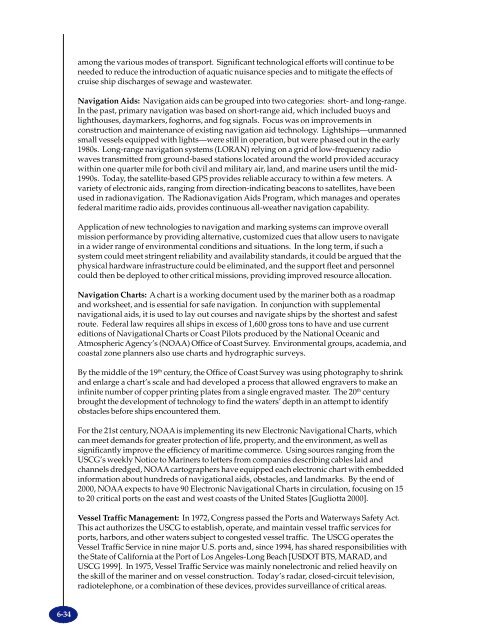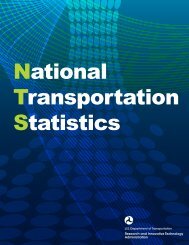TRANSPORTATION - BTS - Bureau of Transportation Statistics
TRANSPORTATION - BTS - Bureau of Transportation Statistics
TRANSPORTATION - BTS - Bureau of Transportation Statistics
Create successful ePaper yourself
Turn your PDF publications into a flip-book with our unique Google optimized e-Paper software.
among the various modes <strong>of</strong> transport. Significant technological efforts will continue to beneeded to reduce the introduction <strong>of</strong> aquatic nuisance species and to mitigate the effects <strong>of</strong>cruise ship discharges <strong>of</strong> sewage and wastewater.Navigation Aids: Navigation aids can be grouped into two categories: short- and long-range.In the past, primary navigation was based on short-range aid, which included buoys andlighthouses, daymarkers, foghorns, and fog signals. Focus was on improvements inconstruction and maintenance <strong>of</strong> existing navigation aid technology. Lightships—unmannedsmall vessels equipped with lights—were still in operation, but were phased out in the early1980s. Long-range navigation systems (LORAN) relying on a grid <strong>of</strong> low-frequency radiowaves transmitted from ground-based stations located around the world provided accuracywithin one quarter mile for both civil and military air, land, and marine users until the mid-1990s. Today, the satellite-based GPS provides reliable accuracy to within a few meters. Avariety <strong>of</strong> electronic aids, ranging from direction-indicating beacons to satellites, have beenused in radionavigation. The Radionavigation Aids Program, which manages and operatesfederal maritime radio aids, provides continuous all-weather navigation capability.Application <strong>of</strong> new technologies to navigation and marking systems can improve overallmission performance by providing alternative, customized cues that allow users to navigatein a wider range <strong>of</strong> environmental conditions and situations. In the long term, if such asystem could meet stringent reliability and availability standards, it could be argued that thephysical hardware infrastructure could be eliminated, and the support fleet and personnelcould then be deployed to other critical missions, providing improved resource allocation.Navigation Charts: A chart is a working document used by the mariner both as a roadmapand worksheet, and is essential for safe navigation. In conjunction with supplementalnavigational aids, it is used to lay out courses and navigate ships by the shortest and safestroute. Federal law requires all ships in excess <strong>of</strong> 1,600 gross tons to have and use currenteditions <strong>of</strong> Navigational Charts or Coast Pilots produced by the National Oceanic andAtmospheric Agency’s (NOAA) Office <strong>of</strong> Coast Survey. Environmental groups, academia, andcoastal zone planners also use charts and hydrographic surveys.By the middle <strong>of</strong> the 19 th century, the Office <strong>of</strong> Coast Survey was using photography to shrinkand enlarge a chart’s scale and had developed a process that allowed engravers to make aninfinite number <strong>of</strong> copper printing plates from a single engraved master. The 20 th centurybrought the development <strong>of</strong> technology to find the waters’ depth in an attempt to identifyobstacles before ships encountered them.For the 21st century, NOAA is implementing its new Electronic Navigational Charts, whichcan meet demands for greater protection <strong>of</strong> life, property, and the environment, as well assignificantly improve the efficiency <strong>of</strong> maritime commerce. Using sources ranging from theUSCG’s weekly Notice to Mariners to letters from companies describing cables laid andchannels dredged, NOAA cartographers have equipped each electronic chart with embeddedinformation about hundreds <strong>of</strong> navigational aids, obstacles, and landmarks. By the end <strong>of</strong>2000, NOAA expects to have 90 Electronic Navigational Charts in circulation, focusing on 15to 20 critical ports on the east and west coasts <strong>of</strong> the United States [Gugliotta 2000].Vessel Traffic Management: In 1972, Congress passed the Ports and Waterways Safety Act.This act authorizes the USCG to establish, operate, and maintain vessel traffic services forports, harbors, and other waters subject to congested vessel traffic. The USCG operates theVessel Traffic Service in nine major U.S. ports and, since 1994, has shared responsibilities withthe State <strong>of</strong> California at the Port <strong>of</strong> Los Angeles-Long Beach [USDOT <strong>BTS</strong>, MARAD, andUSCG 1999]. In 1975, Vessel Traffic Service was mainly nonelectronic and relied heavily onthe skill <strong>of</strong> the mariner and on vessel construction. Today’s radar, closed-circuit television,radiotelephone, or a combination <strong>of</strong> these devices, provides surveillance <strong>of</strong> critical areas.6-34
















